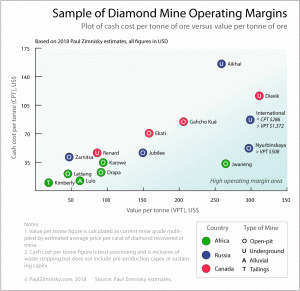Given that most of the high-economic diamond deposits in the world have already been put into production, diluted via expansion, or depleted, going forward the economics of diamond mines will inevitably gravitate towards higher-cost, lower-value operations. Miners are left with a fairly limited decision to replenish their declining resource bases by either discovering or buying greenfield1 projects or expanding their existing legacy mines, thereby elongating the life of mine but typically at lower-quality economics.
The uncertainty surrounding greenfield projects tends to be a risky proposition given the operational complexities of a brand-new mining operation, constantly changing economics based on real world variables, and substantial financing and capital expenditure requirements, especially in the case of Canada’s remote arctic north for example. In addition, geopolitical risk also plays a significant role in the case of jurisdictions like Angola, Zimbabwe, or the DRC. Further, Russia, the largest diamond producing nation in the world, is off-limits to outsiders as the country considerers diamonds a strategic resource.
Expansion projects tend to offer lower risk relative to greenfield projects given that operational, economic, and geopolitical risks have already been experienced, reconciled or at least properly gaged. That said, expansion projects in some cases can be as costly as new mine construction, in the billions of dollars, especially if the project involves a large new open-pit “cut” or transitioning from an open-pit to underground operation.

The figure above provides a sample of current diamond mine operating margins based on 2018 estimates, where operating margin is considered value per tonne of ore at a given mine minus the cash cost to produce a tonne of ore at the mine. The mines falling on the bottom right quadrant of the figure are shown to be of highest margin. In general, mine...

